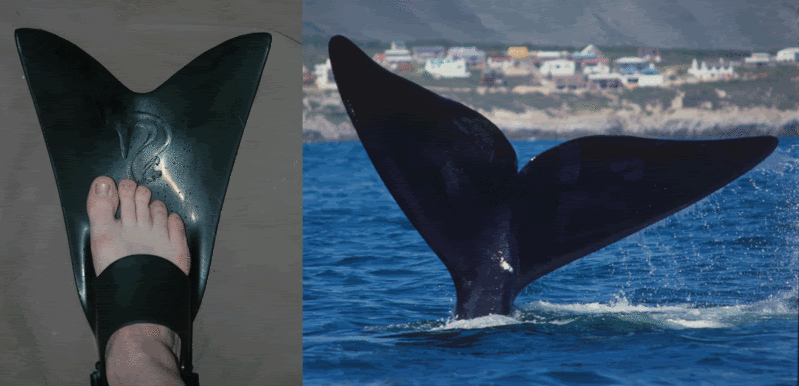Blackwood
Contributor
Cool, thanks! The original site linked required an expensive paid membership. Hopefully I will be able to follow it. Patents are somewhat obtrusively written.
Welcome to ScubaBoard, the world's largest scuba diving community. Registration is not required to read the forums, but we encourage you to join. Joining has its benefits and enables you to participate in the discussions.
Benefits of registering include
This sounds like a job for Mythbusters!
When Apollo was first approached with the Nature's Wing fin it had already been declined by most major SCUBA manufacturers. They were afraid. They thought it was too radical.
The Founder and President of Apollo Japan, Seiji Hattori, a very experienced and talented engineer, when he first tested the prototype fins directed that we sell our paddle fin molds-which we did-Dive-Rite purchased the molds. Dive-Rite now has an excellent paddle style fin.
Mr. Hattori then went on a quest to find the right material and the right design parameter to produce the optimum split fin. It took more than a year and a half and many millions of dollars. We use all natural rubber and the very time consuming and expensive compression molding process to produce the Apollo bio-fins.
The others soon copied us, naturally, many using injection molding, inexpensive materials, and pricing up against us, just because they could. That's business. We do not dwell on that. What we want to do is produce the finest fin we can.
The split fins, as you have noted, work on the basis of different pressure flow. Since water is much denser than air the fluid dynamics work to create the forward thrust.
SPLIT-FINS - SPLIT-FIN TECHNOLOGY has several illustrations that illustrate the method that produce thrust and force with split fins. These illustrations have been posted a number of times.
There will always be the types who say-this can't be true-I love my "whatever" fins. So be it.
Paddles work for ducks and frogs. A properly designed split fin, using the correct materials, provides power, thrust, without excessive strain. Just a look at a Dolphins fin or a whales tail should be enough to know that Mother Nature did not design paddle style fins for these mammals, their fins deflect and twist like a properly designed split fin.
Another good design is the Force Fin, based on Bob Evan's study of the Marine world.
This argument will go on and on. Decide for yourself. All the best for lots of good diving, no matter what fins fits your fancy.

With regard to the split fin patent, I read somewhere that Bob Evans (Force Fin) was the first person to come up with the split-V design...but the "full" split fin was patented by Nature's Wing which employed Peter T. McCarthy (patentholder on record). Does anyone know if there is any truth to this? I see this as relevant to the design "genealogy" of the split fin.
I am interested in learning if the improved performance of split fins is fact or fiction, but I will not be reading the entire patent application as such documents are long on definitions and short on data.
My work spans the range between fundamental research and the evaluation of engineering development models. Whoever the researcher is, they would have had to have convinced their managers and investors using tables and figures which contain experimental data. That would be useful to have in evaluating split fin performance.
If the question is to explain the dynamics of how/why a split fin works, well to paraphrase UofBuffalo study, the dynamics of a swim fin is a vaguely understood art, further study will be required to quantify how and why fins work and explain their interaction with the human. its a really tough problem, as the shape of the fin changes relative to force imparted, which is of course already a non linear problem as both shape and angle of attack are independent variables, and the interface with the human leg is even more poorly understood and changes with each diver (based on technique and fitness, among others) and the fin itself as short or flexible fins allow high cadence, while longer or stiffer fins use slower higher power kicks and both concepts have been shown to be very efficient.
Actually, there is a patent for a split fin dating back to the 1960's. The name of the patent holder is Mann. Bob Evans came up with the design independently and with improvements in the 1980's. The original Force Fin patent includes a disclosure of an elongated Force Fin, eg., a split extending as long as in its Foil Force Fin, which, incidentally, does work on lift because of its compound curvatures, not because of its split.
This is not Bob responding, although I am on his computer.
And, Michael Brennan at Apollo, you lost the right to ascribe yourself credibility by mentioning Bob's name the night we looked at the stars together. Don't do it again.
Here's a link to the 2003 UHM paper by Pendergast et al. (Univ. of Buffalo).there was a very long study performed at the University of Buffalo that discussed the split fins, however its highly technical and thus poorly understood.
@mpetryk: Read the paper I linked to in my previous post. It contains a lot of interesting info.From this point onwards I will assume that this thread will have become polluted with feelings and devoid of scientific fact. I am a scientist by training and profession. If there is some concise scientific research that can be looked at (preferably peer-reviewed), I will take a look at it- please PM me. Until such time, bicker on in this post all you want.
